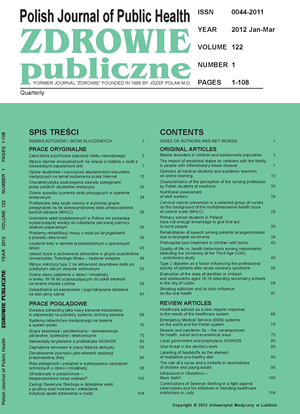Leczenie bólu w okresie przedszpitalnym u oparzonych dzieci
Słowa kluczowe:
ból, postępowanie przedszpitalne, oparzenia, dzieciAbstrakt
Wstęp. Oparzenia stanowią jeden z najcięższych urazów wieku dziecięcego. Do najważniejszych działań w udzielaniu pomocy dziecku oparzonemu należy wdrożenie leczenia przeciwbólowego w okresie przedszpitalnym. Niestety wśród lekarzy zrozumienie roli tego leczenia nie jest zadawalające.
Cel. Celem pracy była ocena pierwszej pomocy medycznej w aspekcie leczenia przeciwbólowego u dzieci oparzonych.
Materiał i metody. Badaniem retrospektywnym objęto 193 dzieci, które zgłosiły się w ciągu roku z powodu oparzenia do Oddziału Klinicznego Medycyny Ratunkowej dla Dzieci w Łodzi. W oparciu o dokumentację medyczną poddano analizie ich sposób zaopatrzenia przeciwbólowego.
Wyniki. W badanej grupie odnotowano przewagę chłopców (57,5%) oraz dzieci do 4 roku życia (61%). Najczęstszą przyczyną urazu było oblanie gorącym płynem (81% badanych). Oparzenie najczęściej dotyczyło szyi/twarzy – 36 dzieci (17%), klatki piersiowej – 67 dzieci (33%), kończyny górnej – 60 dzieci (29%) i były to głównie oparzenia powierzchowne – 154 dzieci (75%). Leki przeciwbólowe otrzymało 12 spośród 23 dzieci przywiezionych przez zespoły ratownictwa medycznego, 4 spośród 20 dzieci zaopatrzonych w POZ i 30 spośród 150 zaopatrzonych przez rodziców. Analiza statystyczna nie wykazała istotnych różnic między podmiotami wdrażającymi leczenie przeciwbólowe u oparzonych dzieci w odniesieniu do liczby dzieci, które otrzymały leczenie. Zaobserwowano jednak różnice dla zespołów ratownictwa medycznego na poziomie p<0,01 i dla rodziców p<0,05 w odniesieniu do ogółu. Nie zaobserwowano istotnych różnic między wdrożeniem leczenia przeciwbólowego a wiekiem dziecka, lokalizacją i głębokością oparzenia oraz kwalifikacją do leczenia szpitalnego. Przeprowadzone badania potwierdziły brak umiejętności udzielania pierwszej pomocy oparzonym oraz o niedostateczną jakość przedszpitalnej pomocy medycznej.
Wnioski. Koniecznym wydaje się opracowanie jednolitego algorytmu leczenia bólu u oparzonych dzieci w zależności od stopnia ciężkości oparzenia oraz intensyfikacja kształcenia lekarzy, pielęgniarek i ratowników w zakresie leczenia bólu u dzieci oparzonych.
Bibliografia
1. Chęciński P. Rozwój embrionalny i anatomia topograficzna krtani i gardła dolnego. Rak krtani i gardła dolnego. Bielsko Biała: Wyd. Alfa-medica Press; 2002. p. 30-49.
2. Zalesska-Kręcińska M, Kręciński T. Zarys otolaryngologii. Wrocław: Akademia Medyczna im. Piastów Śląskich; 2006.
3. Boffetta P, Richiardi L, Berrino F, et al. Occupation and larynx and hy¬popharynx cancer: an international case-control study in France, Italy, Spain and Switzerland. Cancer Causes Control. 2003;14(3):203-12.
4. Janczewski G. Guzy głowy i szyi. Otolaryngologia u schyłku XX wieku. Gdańsk: Via Medica; 2001. p. 95-7.
5. Leppert W, Majkowicz M, Łuczak J, et al. Ocena jakości życia u cho¬rych z bólem nowotworowym leczonych tramadolem i morfiną. Psy¬choonkologia. 2002;6(1):1-8.
6. Zatoński W, Zatoński T. Epidemiologia nowotworów złośliwych krtani. W: Rak krtani i gardła dolnego. (ed.) Janczewski G, Osuch-Wójcikiewicz E. Wyd. α-medica Press, Bielsko-Biała 2002, 22-23
7. Wierzbicka M, Szyfter K, Bień S, et al. Zalecenia diagnostyczno-tera¬peutyczne dla wybranych nowotworów głowy i szyi. Rak gardła. Współ Onkol. 2006;5:202-8.
8. Ackerstaff AH, Hilgers FJM, Aaronson NK, et al. Communication func¬tional disorders and life style changes after total laryngectomy. Clin Oto¬laryngol. 1994;19:295-300.
9. Sinkiewicz A, Betlejewski S, Betlejewski A, Mackiewicz H. Propo¬zycje standardów postępowania rehabilitacyjnego po laryngektomii całkowitej. Otolaryngol Pol. 2004;58(4):753-6.
10. Fabczak-Kowalczuk AM. Dzienniczek mowy. Białystok: Wyd. Buk; 2005.42 Zdr Publ 2012;122(1)
11. Krzewicka A, Czernicki J. Rehabilitacja chorych z zaburzeniami głosu i mowy po laryngektomii całkowitej. Przegl Wojsk. 1999;41:499-503.
12. Pruszewicz A, Obrębowski A, Borucińska-Tyczyńska J. Wpływ niek¬tórych czynników socjalnych i psychicznych u laryngektomowanych na rehabilitację zastępczego procesu komunikatywnego. Otolaryng Pol. 1997;31(3):271-6.
13. Wierzbicka M, Wójtowicz JG, Kuśnierkiewicz M, et al. Badanie jakości życia u chorych z nowotworami głowy i szyi w oparciu w oparciu o standaryzowane kwestionariusze EORTC QLQ C-30, EORTC QLQ-H&N35. In: M. Rogowski (ed) Postępy w otolaryngologii. Mikołajki: Triangulum; 2002. p. 62-71 .


